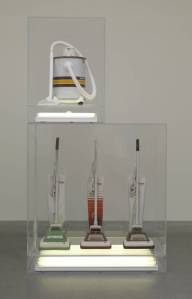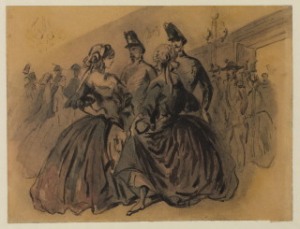This project is concerned with the Marxist concept of Fetishism of the Commodity. Having read Marx’s original essay of the same name, the project calls for a number of questions to be answered.
Does the article help us to understand the art market?
Marx’s view is that the intrinsic value of products manufactured through the labour of the proletariat is fundamentally changed when they are traded by the owners of manufacturing entities. They become commodities and their value is no longer linked to the intrinsic value of the materials and labour of which they are made. Their value is determined by the market. As commodities they can achieve values which far outstrip their fundamental worth. Fashion, Brand sponsorship, advertising, packaging etc all contribute to the value of the commodity. In Marx’s words when something is commoditised it becomes fetishised.
The art market thrives on such fetishism or mystification. One of the best illustrations of how this takes place is the Leonardo Cartoon of the Virgin and Child purchased by the National Gallery. John Berger describes this event in Ways of Seeing. An American wanted to buy the Cartoon and the National Gallery launched a nationwide appeal to raise the £2.5 million needed to buy it and keep it for the Nation. As a consequence the work has taken on a special significance and mystification. It is the most visited exhibit in the Gallery. It has its own special viewing gallery. More postcards of this work are sold than for any other work in the Gallery. None of this is because of what the work shows, because of its meaning, or for that matter because it is the only Leonardo cartoon. Rather the work has been mystified because of the high value placed upon it by the art market. The work has become special because of its market value. All reference to its intrinsic value has now been subsumed to the market.
Does the article help explain the work of artists such as Jeff Koons
Rather ironically Jeff Koons is a former commodities broker. He has gained a certain notoriety in the art world through his way of appropriating everyday objects with little or no aesthetic or artistic value and transforming them in to works of art for the gallery. You get the feeling that Koons is poking fun at the commoditisation of art and those who get sucked into this market. Koons work seems to divide opinion in the art market. In my view Koons’ works are largely ironic and challenge both the fetishisation of consumer goods and the commoditisation and mystification of art. Koons talks about the need for the viewer to overcome the sense of shame induced by the art world at taking pleasure from apparently banal imagery. Marx’s ideas are implicit in the critique offered by Koons’s work.
Some examples of Koons’ work
New Hoover Convertibles, Green, Red, Brown, New Shelton Wet/Dry 10 Gallon Displaced Doubledecker 1981-7 is a Koons work owned by the Tate Modern in London.

New Hoover Convertibles, Green, Red, Brown, New Shelton Wet/Dry 10 Gallon Displaced Doubledecker 1981-7
As can be seen this work comprises of several hoover vacuum cleaners mounted in a perspex cabinet. The hoovers are all brand new and it is this newness which Koons feels gives them their special appeal. Suspended in the glass cabinets they retain their newness for ever.
Winter Bears 1988 is a second exhibit from the Tate Modern London.

Winter Bears 1988
These Kitch ornaments now find pride of place in one of the top art galleries in the UK. The ceramic statues are made by highly skilled craftsmen to the highest artistic standards but the subject matter is banal in the extreme. Koons is perhaps challenging the conventional preconceptions of style and taste.
Three Ball 50/50 Tank (Two Dr. J. Silver Series, One Wilson Supershot) is a work owned by MOMA in New York. It comprises of three basketballs suspended in water in sealed plastic tanks on a steel frame.

Three Ball 50/50 Tank (Two Dr. J. Silver Series, One Wilson Supershot)
Here again Koons is idealising everyday objects and placing them in the gallery context. One is left wondering if he is mocking the art establishment. The basketballs have not been treated in any way so that over time they will deteriorate. Perhaps Koons intended this to show how ephemeral commodity goods are and by association art is.
Examples of other artists working in a similar way
Andy Warhol preceded Koons by many years and was arguably the first to transform everyday commodities into art objects. His silkscreen print of Campbells Soup cans are an example of his work.

Campbell's Soup Can 1964 by Andy Warhol
Warhol was a ‘Pop’ artist and took everyday items and reproduced them in an artistic form and sold them as works of art. By doing this he and his fellow artists were effectively striking a blow against the art establishment who made a clear distinction between highbrow and lowbrow art. Rather ironically Warhol’s work is now extremely valuable.
Katharina Fritsch is a German sculptor whose work resembles that of Koons. ‘The Rat King’ is one of her best know works.

The Rat King by Katharina Fritsch
In this work she sculpted a ring of life-sized rats. Each rat is eight feet tall, and perched on its hind legs. Facing outwards they cautiously raise their tiny front paws in suspicious guard. Inside their circle is a knotted configuration, made by the intertwining of each rat’s tail. The work takes an apparently banal subject – the rat – and by the use of scale and repetition creates an image which has an unsettling quality. The work capitalises on our unease about rats and their historic role in spreading deadly disease. Kitch takes on a mythic quality!!
Sources
Mirzoeff, N. (ed). (2002) The Visual Culture Reader Second edition. Oxford: Routledge
Berger, J. (1990) Ways of Seeing. London: Penguin
Tate Modern, London, http://www.tate.org.uk/servlet/ArtistWorks?cgroupid=999999961&artistid=2368&page=1 14/11/11
Tate Modern, London, Past Exhibitons, Katharina Fritsch 7 September to 9 December 2001, http://www.tate.org.uk/modern/exhibitions/fritsch/default.htm 14/11/11
Museum of Modern Art, New York, Collections, http://www.moma.org/collection/object.php?object_id=79809 14/11/11












